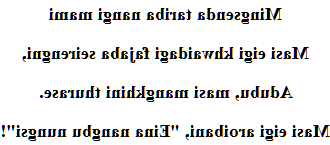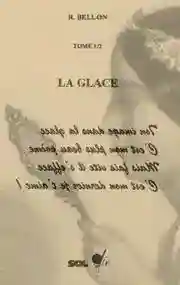Meithei love poem
Mingsel
Mingsenda tariba nangi mami
Masi eigi khwaidagi fajaba seirengni,
Adubu, masi mangkhini thurase.
Masi eigi aroibani, "Eina nangbu nungsi"!

Converted to Meitei Mayek script
ꯃꯤꯡꯁꯦꯜ
ꯃꯤꯡꯁꯦꯪꯗ ꯇꯔꯤꯕ ꯅꯉꯤ ꯃꯃꯤ
ꯃꯁꯤ ꯑꯦꯏꯒꯤ ꯈ꯭ꯕꯥꯏꯗꯒꯤ ꯐꯖꯕ ꯁꯦꯏꯔꯦꯡꯅꯤ,
ꯑꯗꯨꯕꯨ, ꯃꯁꯤ ꯃꯡꯈꯤꯅꯤ ꯊꯨꯔꯁꯦ꯫
ꯃꯁꯤ ꯑꯦꯏꯒꯤ ꯑꯔꯣꯏꯕꯅꯤ, "ꯑꯦꯏꯅ ꯅꯡꯕꯨ ꯅꯨꯡꯁꯤ"!

→ French poem ←
Meithei language
Meitei love poem (other names : Meithei, Manipuri, Meetei, Hindu Meitei, Menipuri, Mitei, Meeteilon, Kathe, Kathi, Loi, Manipuri Muslim, Meiteilon, Meiteiron, Meithe, Mithe, Pangal, Pangan, Panal, Panan, Ponna, Autonym : মৈতৈলোন্ (Meiteilon)).
Manipuri is an Indo-Aryan language, spoken in India, in the state of Manipur, where it is the official language.
2 million people understand this polysyllabic language which for some belongs to the Sino-Tibetan language family, and for others, to the Kukois group of Tibetan-Burmese languages which, however, are all monosyllabic, but it It is true that the classification of languages is done first on grammar before being done on vocabulary.
If this language were Sino-Tibetan, that would say that it is the most widely spoken Sino-Tibetan language in India.
In principle the meiteilon is written with a particular script (the meitei mayek). For this translation I only have a romanized version, but it will have the advantage of giving you an idea of how to be said.
Initially the Indo-Aryans of Manipur spoke Sanskrit (4th century BC), which gradually drifted towards Prakrit (3rd century), then towards Apabhransha (6th century). Later Manipuri arose from the combination of Apabhransha with Mongoloid languages. Linguists place this there are perhaps 1,000 years.
If the base is Sanskrit, Thai (the language of the Pongs of Upper Burma), Bengali of the Brahmans, English and Portuguese have interacted with the language.
When the British arrived at the very end of the 19th century, the schools they founded taught in English or Bengali, so it had become urgent for the natives of the Manipur kingdom if they wanted to preserve their language, and therefore preserve themselves, to be able to standardize and write in Manipuri.
Today the meitei is the lingua franca in all the Manipur kingdom, and in India the constitution recognizes its teaching at the university.
Manipur and Metheis
Manipur, which in Sanskrit means "the land of gems", is a name that the Meitheis adopted in the 18th century.
Previously the Manipur was called Meitei Leipak and Poireinamthak Saron Pung; there are also Tilli Kokton Ahanba, Mirai Pongthoklam, Hana Semba Konna Loiba and Muwapalli.
This state of the extreme east of India between Burma, Nagaland, Mizoram and Assam is located in the chain of Arakan; Manipur has 92% of mountainous territory. All these mountainous parts constitute an important forest reserve.
The Meithei society, structured in clans which give great importance to lineages, continues to practice the form of tribal religion which results from it, the cult of the ancestors.
The festivals which are the fulcrum for community rituals, around legends, continue to perpetuate and weld the membership in the Meitei community.